October 2022
Monthly Archive
Mon 31 Oct 2022
Posted by Steve under
Reviews[6] Comments
REVIEWED BY DAVID VINEYARD:
BASIL COPPER – The Curse of the Fleers. Harwood-Smart, UK, hardcover, 1976. St. Martin’s, US, hardcover, 1977. PS Publishing, UK, hardcover, 2012 (restoring the text of the author’s original manuscript).
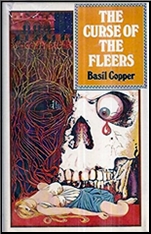
A well done Gothic melodrama for the season.
Though Daphne Du Maurier’s Rebecca was as unblushing a gothic tale as was ever written, replete with the Rochester like Maxim de Winter and the faintest blush of the supernatural in the person of the title character and her mad housekeeper, the result of that novel and films success was that the Gothic novel took a tack into largely the women’s market, in books written almost exclusively by women and for women.
Defined as a woman gets house genre, the model followed Du Maurier and Bronte’s Jane Eyre slavishly. A woman, always young and somewhat inexperienced, usually a governess, comes to a strange household usually finding an eccentric family haunted by the past, an attractive but distant, cold, and cruel male and a more charming, but not always trustworthy type.
Not every book in the genre followed that model exactly, and I am not in the least condemning those that did. Mary Stewart. Norah Lofts, Phyllis Whitney, Dorothy Eden, Victoria Holt, and others working in the genre are some of the best writers of their era, but the true Gothic spirit got a bit lost in the mix.
Oh, there were books that did fit the original definition, Dorothy MacArdle’s The Univited, Francis Beeding’s The House of Doctor Edwards, Jesse Douglas Keruish’s The Undying Monster, Russell Kirk’s The Old Dark House of Fear, William Sloane’s Edge of Running Water and To Walk Alone, Tom Tryon’s Harvest Home, and Shirley Jackson’s The Haunting of Hill House fit the “Gothick†tradition like a glove. And so did Basil Copper’s The Curse of the Fleers, and it might have been recognized as such if it hadn’t been butchered by its first publisher to the point the author turned his back on it.
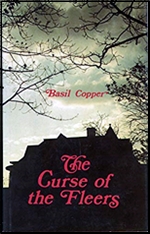
Now a restored edition brings the book back into its full Gothic glory replete with Copper’s extensive notes on writing the book appended to the ending.
Captain Guy Hammond is a forty something veteran of the wars in Afghanistan facing the end of his military career as he recovers from a leg wound in London.
It was early October and the golden splendour of the day was giving way to a dry and misty evening. The clamour of London rose, agreeably distant, to the upper storeys of the small hotel; the grating of the hansom cabs; the rattle of heavier vehicles such as drays; and the distinctive thunder of laden horses-buses passing on the busy thoroughfare’’’
Hammond, a bit like Dr. Watson, is a man with little family and no direction in life until he gets an urgent letter from former Lt. Cedric Fleer begging him to come to their estate Fleer in Dorset. “I cannot go into details but, for friendship’s sake. I should be grateful for your help and advice. This business becomes blacker with every passing day and I fear for my father’s sanity.â€
“There’s an ancient curse attached to my family,†Cedric Fleer tells Hammond. “Something about a Creeping Man…â€
What red blooded Victorian male could resist that? But as Hammond gets closer to Fleer a sense of foreboding overtakes him. And with good reason. Beneath its battlements, Fleer is a vast uninviting place, however welcoming Sir John, Cedric’s father, and his attractive younger sister Prudence, and beautiful Claire Anstey. The countryside is cold and damp and the nearest neighbor Sir Jeffrey Darnley sullen and threatening.
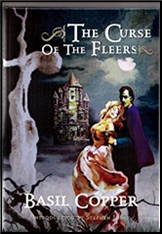
Basil Copper was a popular British writer who made his mark in the latter day Lovecraftian movement and followed August Derelith in writing the popular Solar Pons stories. His novels include the Lovecraftian The Great White Space, the Victorian Gothic detective story Necroscope, and the horror novel House of the Wolf. In addition he had some success with his L.A. based private eye series about P.I. Mike Faraday (even though he never visited Los Angeles), and wrote the Lee Falk Phantom paperback original novels for Avon. He was nominated for a Locus Award for best Fantasy novel and his story “Camera Obscura†was adapted for Rod Serling’s Night Gallery.
One flaw built into the Gothic is that with all the build up too often the payoff is a disappointment. All that portent and heavy breathing, those sideways looks, the sudden breeze and cold, the faint noise that can’t be explained, shadows, and things barely perceived can add up to nothing much and disappear with a little light and a fresh breeze off the sea in lesser hands, or descend into overdone melodrama and sturm un drang. Many a perfectly good Gothic falls apart as the cobwebs get blown too conveniently away and the reader is left with a resounding, “so what?â€.
John Dickson Carr borrowed the trappings heavily in his detective novels, usually avoiding the pitfalls and often exceeding expectations, while writers like Helen McCloy (Through a Glass Darkly and Mister Splitfoot), Hake Talbot (Rim of the Pit), and William Lindsey Gresham (Nightmare Alley) teased the edges of the genre. Wilson Tucker’s Warlock even managed to work the spy novel into the mix, but the classic gothic take was usually eschewed for something else, the detective story, the horror novel, or science fiction.
Not Copper, and not Fleers. The elements ratchet up nicely without boiling over, the tension gathering, the mystery deepening, and the ending well choreographed replete with logical explanation, a death trap worthy of Dick Tracy, and of course the inevitable treasure of the Fleers. Elements of the detective novel and horror may play at the edges, Hammond does some good detective work, but they are not the main thrust of the tale.
That is pure Gothic. This would be silliness in a fair play detective story. In a true Gothic it is par for the course.
Originality isn’t really what we are looking for in these kinds of entertainment. It’s the comfort of the familiar played out with intelligence and an eye to teasing our expectations while never disappointing them, here with the Creeping Man seen haunting the battlements and a giant gorilla in a private zoo as well as bodies hanging strangled in closets as Hammond investigates and begins to uncover very real motives for murder and the methods of committing them it all builds to what Copper himself called a Grand Guignol finale.
Hammond felt a tension rising within him. A certainty that had been growing all day. There was a muffled grunt from Cobbett and a hissing cry from Fleer as the face came into view. The Inspector fumbled with the crumpled visage of wrinkled flesh that Hammond remembered only too well from the Yew Walk. The rubber mask stripped away to reveal the distorted, terror-stricken face of a …man with a ….
Cedric Fleer stumbled back, his face as white as paper. “My God! …â€
And this time the guy gets the house and the girl and a career.
About time too.
Sat 29 Oct 2022
Posted by Steve under
Reviews[4] Comments
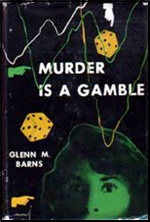
GLENN M. BARNS – Murder Is a Gamble. Jonathan Marks #1. Phoenix Press, hardcover, 1952. Bestseller Mystery B162, digest paperback, 1954?
Jonny Marks of the Watson Agency is hired as a bodyguard for a slightly phoney but still likable Colonel Smallwood, who turns out to be a small-time card sharp and con-man with one last important deal in the works. Marks does save him from a beating by some mobsters om a nightclub but not from a “suicide†on a sealed-off floor of his hotel.
A perfectly ordinary tale on which every other character is a ninny; otherwise no major offenses. The “locked room†mystery is nothing to startle, but it works neatly enough to be noted. Barns might have made something more out of this [had he given more editorial assistance than I am sure Phoenix Press was willing or able to provide].
Rating: C
– Slightly revised from The MYSTERY FANcier, January 1977 (Vol. 1, No. 1)
Bibliographic Update: This was the first of eight mystery novels written by Glenn Barns. There was a second case recorded for PI Jonathan Marks, that being Murder Is Insane (Lippincott, 1956).
Fri 28 Oct 2022
Posted by Steve under
Reviews[5] Comments
REVIEWED BY TONY BAER:
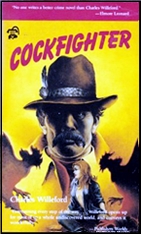
CHARLES WILLEFORD – Cockfighter. Chicago Paperback House, paperback, 1962. Crown, hardcover (slightly revised), 1972. Avon, paperback, movie tie-in, 1974. Black Lizard, paperback, 1987.
If you’re still looking for the great American novel, this could be it.
George Washington wrote a letter to General Lafayette saying: “It will be worth coming back to the United States, if only to be present at an election and a cocking main at which is displayed a spirit of anarchy and confusion, which no countryman of yours can understand.†One may want to remember this point, which we may be in danger of forgetting.
Frank Mansfield is a cockfighter. He’s 32 and single. Cockfighting is his life. And his life’s goal is to win the Cockfighter of the Year award. He’s taken a vow of silence and will not speak again until and unless he wins the award.
The story is of the single-minded purpose and commitment of a man alone in the world but for the signal pursuit that he himself has freely chosen and the cockfighting community in which he thrives.
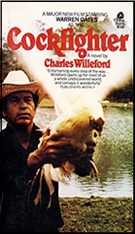
It’s a story of honesty, brutality and commitment. There are four things we can learn from a rooster: To fight, to get up early, to eat with your family, and to protect your spouse when she gets into trouble. Frank Mansfield has no spouse or family. But two out of four ain’t bad.
The honesty of the sport is impeccable as a peck of pecking peckers. A cock couldn’t throw a fight even if it knew how.
I’d last read this book in the mid-90’s and considered it a favorite. But sometimes it’s good to see if my assessments of yore hold true. And as old Heraclitius pointed out ‘you can’t step in the same river twice’ because you’ve changed and so has the river.
Well, if I loved the book before I love it even more now. This book is as good as it gets. It’s about cockfighting, sure. But more than that it’s about life, about commitment to something, never mind what the hell it is. And fighting for it with everything you’ve got, risking everything. Like Camus said, “A reason for living is also an excellent reason for dying.â€
—-
In 1974 was made into a movie starring Warren Oates, Harry Dean Stanton, and Charles Willeford. Directed by Monte Hellman (who also made the terrific Two-Lane Blacktop starring Dennis Wilson and James Taylor).
https://tubitv.com/movies/466939/cockfighter
Thu 27 Oct 2022
Posted by Steve under
Reviews[5] Comments
REVIEWED BY MIKE NEVINS:
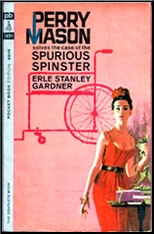
ERLE STANLEY GARDNER – The Case of the Spurious Spinster. Perry Mason #64. William Morrow, hardcover, 1961. Pocket #4515, paperback, 1963. Reprinted many times since.
This was one of Anthony Boucher’s favorite late Masons, but I found little to praise in it except for Gardner’s never-failing story-telling pace and drive.
The plot has to do with corporation intrigue over a non-productive mine, a shoebox full of dubious cash, the impersonation of the company’s irascible female owner and, as if you hadn’t guessed, a murder.
But all the story elements remain chaotic and incredible by the fadeout, and even the courtroom sequence is weak, with Mason given little chance to shine. Gardner must have dictated this adventure on an off day.
– This review first appeared in The MYSTERY FANcier, January 1977 (Vol. 1, No. 1)
Wed 26 Oct 2022
Posted by Steve under
Reviews[8] Comments
REVIEWED BY BOB ADEY:

ANTHONY PRICE – Other Paths to Glory. Dr. David Audley #5. Gollancz, UK, hardcover, 1974. Doubleday, US, hardcover, 1975. Mysterious Press, US, paperback, 1987
When Anthony Price is on form he really. does write a.very good novel of espionage and intrigue – and in this one he’s quite definitely on form. The particularly intriguing puzzle he poses is why should anyone in 1974 want to kill off those few remaining people with expert knowledge about a little known first War battle waged in 1916.
One of the intended victims is young military historian Paul Mitchell, but by sheer luck he survives,·and is at once recruited to find the reasons by Dr. David Audley, that devious agent for the Defence Ministry. The action (and the intrigue) rattle along at a good old pace, and the solution is quite feasible. A book I found myself stealing time to read.
– Reprinted from The Poison Pen, Volume 4, Number 3 (June 1981).
Tue 25 Oct 2022
Posted by Steve under
Reviews[3] Comments
IT IS PURELY MY OPINION
Reviews by L. J. Roberts
S. A. DUNPHY – Bring Her Home. Boyle and Keneally #1. Bookouture. softcover, 2021. Setting: Contemporary Ireland.
First Sentence: I left his body where I knew it would be found, nestled gently in the tidal mud of the Thames in the shadow of the Tate Modern in Southwark.

A man known only by the Celtic rune Uruz murders the former professional and personal partner of criminal behaviorist Jessie Boyle and is now stalking her. After retiring from London’s Metropolitan Police, Jessie returns home to Ireland. Her friend, Dawn Wilson, newly appointed Police Commissioner of Ireland, calls in an old debt.
Penelope (Penny) O’Dwyerhe, the daughter of Ireland’s Taoiseach (Prime Minister) is gone. The kidnapper threatens to kill her unless the police find her first. They have twelve days. Serial killer Frederick Morgan, imprisoned for life, claims he has the information needed to save Penny, but Jessie is the only one with whom he will negotiate. As Boyle and her team investigate, they learn there is much more to Penny than first thought, and that she is not the only woman who has gone missing.
There are a lot of threads and characters in this story. There is much to really like, and Dunphy’s voice galvanizes the reader to continue reading. But there are several things which, upon reflection, cause one to pause.
The book, in some ways, feels introductory, a prologue to the upcoming series while clearly being a story in and of itself. One is introduced to every character, including the secondary ones, with each given a separate chapter detailing their background. As opposed to interfering with the story, the characters are brought to life with even the bad guys given full dimensionality and shades of gray. However, one may wonder at the necessity of this and how many of these characters will reappear in the future.
The principal police characters: Jessie Boyle, Detective Seamus Keneally, genealogist and IT tech Terri Kehoe, and Dawn Wilson are an interesting, diverse team, each with strengths and weaknesses. They contrast and complement each other and are characters one wants to know. When at risk, the tension is palpable as one doesn’t want any harm to come to them.
The story includes quite a bit of ancient folklore and references to Celtic artifacts. While germane to the plot, this slows the pace and can lead to confusion with the number of characters who spiral off the person who fashions himself after the folklore character of Uruz. One already knows he will be back.
Bring Her Home is an exciting read with great characters, occasional good humor, and powerful suspense. The book would have benefited from stronger editing. Even with a satisfactory ending, once one thinks about it, it causes curiosity about the fate of several characters. Book two awaits. It will be interesting to see how things progress.
Rating: Good.
Sun 23 Oct 2022
Posted by Steve under
Reviews[6] Comments
REVIEWED BY TONY BAER:
ICEBERG SLIM – Mama Black Widow. Holloway House, paperback, 1969, as by Robert Beck. Also published as by Iceberg Slim: Holloway House, UK, hardcover, 1992, and Holloway House, US, paperback, 1996, as well as several later printings. (Anything published by Holloway House has a complicated printing history; corrections gratefully accepted.)
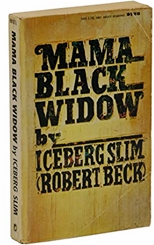
The nightmare life story of Otis Tilson, a Black drag queen born on a Mississippi plantation in the 20’s, living until the end of the 60’s in the Chicago ghettos.
In the intro, Iceberg Slim claims that the book is a transcript of a 1969 tape recording of the flamboyant drag queen Otis Tilson (Tillie). Now normally I don’t care if something is ‘true’ or ‘fiction’ as long as it’s good. And, to me, the difference between non-fiction and fiction is blurrier than we’d like to admit. But whatever. The only reason I bring it up is that if it is a work of fiction, one really can question what the point of it is. Oscar Wilde says: “We can forgive a man for making a useful thing as long as he does not admire it. The only excuse for making a useless thing is that one admires it intensely.†So what to make of something both unadmirable and useless?
On the other hand, if it’s just a life story, you might say, ‘it is what it is’. I disagree. One’s life is capable of interpretation just like anything else. Schopenhauer says somewhere that the main difference between the ‘great lives’ we read about in books and the boring lives we live are that we experience our lives in mediocre ways. That were we to experience our lives with great exuberance, verve, desire and will, our lives too would be of magnificent import. And in our life stories magnificent import we’d impart. Cf the films Birdman, Toto le héros, Kiss of the Spider Woman, or even The Secret Life of Walter Mitty or Harvey to see the ways that a crappy life can be redeemed with a bit of imagination.
Anywho. This one is unredeemable.
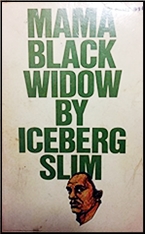
Otis’s father Frank makes his living as a cotton sharecropper and part-time preacher. His father ‘saves’ and marries the beautiful Sedelia, seducing her with the words of Jesus Christ, stealing her away from the brothel life in which she lived with her older cousin Bunny. The father is a strong, proud man, muscular and moral.
Sedelia’s beguiled by tales of indoor plumbing in the jewel bedazzled city of Chicago from cousin Bunny, who has moved there to strut her wares. Sedelia begs and begs then threatens and begs some more til her husband agrees to cash out the farm for $37, leaving the only life he’d ever known, and they move to Chicago.
In Chicago it’s just one disaster after the other. It’s the depression and Frank can’t find work. The trade unions are all whites-only. Praying to Christ for work to support his family, Frank fails. Sedelia starts sleeping with the rich preacher of the local church who drives a Cadillac and showers her with furs. Sedilia flaunts her infidelity in her husband’s face, driving him to drink, diabetes and death.
Meanwhile Otis, at age 9, is molested by a church deacon who promises him that any of his wishes will come true if only he brings tears of joy to his ‘magic wand’. Otis says: “Really? Can your magic wand give my father a job and make my parents stop fighting?†“Absolutely!†exclaims the deacon. But let’s keep it a secret just us two.
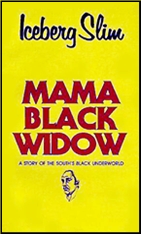
Otis’s sister Carol falls in love with a white chubby baker. But Sedelia has promised Carol to the local numbers shark in exchange for corned beef, jewels and hard cold cash. So when Mama Black Widow (i.e. Sedelia) finds out that 17 year old Carol is planning to elope with the baker and bear his child, Sedelia kicks her in the belly til she miscarries, cuts out the fetus with a razor blade, and throws it in the garbage can. Carol keeps crying ‘why’d you kill my baby’, gets up in the night to retrieve it from the trash, and bleeds to death in the bed clutching her dead fetus to her breast.
It only gets worse from there. Carol’s twin sister Bertha turns to whoring and is immolated by a john, and Frank Jr. avenges her death by killing Bertha’s white pimp, getting sentenced to life without parole.
Otis is only attracted to men. He dresses in drag, and he is quite beautiful. He picks men up at bars, and gets sodomized and beaten. Over and over again.
(SPOILER ALERT)
Then he kills himself.
Then End.
Good lord. Surely one of the bleakest books of all time. And as the title shows, he blames it all on his mother: The Black Widow.
Avoid at all costs unless you’re into self-flagellation. In which case: highly recommended. Also recommended anyone who believes that things couldn’t possibly get any worse.
Sat 22 Oct 2022
REVIEWED BY DAVID VINEYARD:
JACK DAVIES – Esther, Ruth, and Jennifer. Allen, UK, hardcover, 1979. Also published as North Sea Hijack (Star, UK, paperback, 1980). US title: Atlantic Incident (Jove, paperback, 1980).
Film: Universal, 1980, as North Sea Hijack; released in the US as ffolkes; also released as Assault Force. Roger Moore, James Mason, Anthony Perkins, Michael Parks, David Hedison, Lea Brodie, Dana Wynter. Screenplay by Jack Davies based on his novel. Directed by Andrew V. McLaglen.
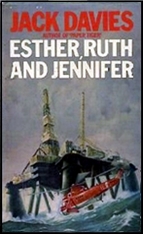
“In his hand he carried an ancient carpet bag with a printed label which read: Rufus Excalibur ffolkes, Skeely, Scotland. It contained what he thought of as his overnight things: pajamas, dressing gown, two spare shirts, more red socks, his shaving kit and comb, the tapestry he had been working on for the last seventeen years, two loaded revolvers, a bottle of Black Label Scotch Whiskey, and the Shorter Oxford English Dictionary; which was his current reading matter. He had reached page 699 the previous night and been delighted to find a word of which he did not know the meaning — filoplume. Of course, he knew filium was Latin for thread and plume was feather, but he had not known the word was used ornithlogically to describe the nearest approach to a hair a bird can have. Just the sort of thing the TIMES crossword would spring on me, he thought.”
Every collector has those books you look for over a period of years and somehow never come across a copy that is available and you can afford, and then when you do find it, it arrives in the mail, and you complete the anticipatory act of opening your acquisition when the inevitable doubt grips you.
Is it any good?
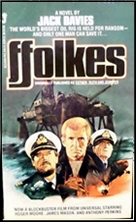
You have spent forty years or more looking for a copy having never read the book, having never read so much as a review of the book, and now it is in your trembling hands, and you face that dilemma; was it worth all this?
In the case of Jack Davies’ Esther, Ruth, and Jennifer, the answer was a resounding, and relieved, yes.
Granted in this case there was a very entertaining action film starring Roger Moore taking a break between Bond outings (Moonraker and For Your Eyes Only) and the screenplay for that was by the novelist, and that writer had written numerous great screenplays, and several good novels, but still, that timorous nagging fear lay heavily on my too often disappointed collectors soul.
Was Esther, Ruth and Jennifer going to be a tremendous let down?
Book and film have the same simple premise. Jennifer and Ruth, the largest of the North Sea Oil platforms have been mined by terrorists who are demanding £25 million or they will be blown-up, crippling North Sea oil production for decades. The hijackers have taken Esther, the state of the art supply ship commanded by Captain Olaffsen, and is holding his crew hostage.
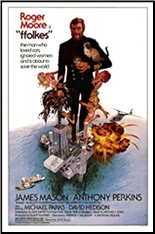
Harold Shulman embezzled from his own company and was sent to prison. There he met psychotic Lew Kramer and they decided to team up, ruthlessness and brutality. The only trick then was to find a target worthy of their ambition.
Anyone who lived through the Seventies probably remembers just how much oil production and prices were on everyone’s mind. Those North Sea Oil Rigs were a lifeline for all of Europe and particularly for the United Kingdom and Norway. I worked on an industrial espionage case involving British Petroleum and the North Sea platforms and the pressure from several governments was intense.
Enter our hero, Rufus Excalibur ffolkes, ex Royal Navy, and eccentric cat loving, woman hating, whiskey (and in kilt-wearing ffolkes’ case that should be ‘whuskey’) swigging, motorcycle enthusiast, and sewing aficionado who has trained his own team of tough sea going privateers for just this sort of thing. Both the British government and the company approach him despite the fact he is almost impossible to work with.
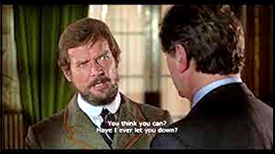
After all, he predicted exactly how the rigs might be hijacked so he has the best chance of saving them.
“We go on as before. We keep practicing assaults on platforms, rigs and ships, unobserved by anyone on them. If any of them is ever successfully hijacked one thing is certain. We will have to deal with the hijackers before they can do any damage.â€
ffolkes’ plan involves his going aboard Jennifer with part of the team assigned to negotiate the ransom, Admiral Brinken of the Royal Navy and Mr. King from the oil company, but things go awry. Then too the Navy and the company are wary ffolkes’ plan which begins with convincing the hijackers that they have made a mistake and Ruth, out of their line of sight, has blown up because of them.
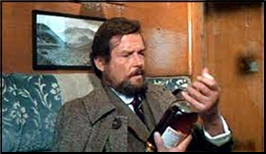
Little can ffolkes expect things will go wrong between rough seas and human error and he will find himself aboard the Esther with one healthy ally he can rely on, Sanna, a female crew member ffolkes mistakenly thinks is a young man at first, as the deadline grows closer.
In the film released in the UK as North Sea Hijack and here as ffolkes it is all in the acting, Moore having great fun as ffolkes, Anthony Perkins as Shulman, Michael Parks as Kramer, James Mason the Admiral, and David Hedison the company representative. On the printed page it is a cleverly and richly told take that, considering the author’s history in film, is a well crafted and often humorous thriller that at times reads as if P. G. Wodehouse was collaborating with Alistair MacLean. The action may be cinematic, but the book compares well with many of the better adventure thrillers of the era by legends in the genre like Canning, Innes, and Bagley.
You never feel as if you are reading a scenario for a film though the film follows the book scene by scene.
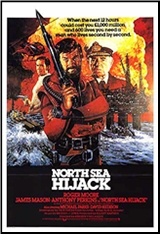
If you love British comedy of the late fifties into the sixties Jack Davies name should be familiar to you from the credits. Jack (John Bernard Leslie) Davies was a British screenwriter whose films include Laughter in Paradise, Doctor at Sea, An Alligator Named Daisy, Gambit, It Started in Naples, The Poppy is Also a Flower, Monte Carlo or Bust (aka Those Daring Young Men in Their Jaunty Jalopies based on his novel), Paper Tiger (with David Niven and Toshiro Mifune also based on his novel) and the Oscar nominated best original screenplay for Those Magnificent Men and Their Flying Machines. His lines read by a veritable who’s who of Hollywood stars including Clark Gable, Sophia Loren, Michael Caine, Shirley MacLane, Alex Guinness, Tony Curtis, David Niven, Yul Brynner, Rita Hayworth, and more.
Three of his four novels were made into films unsurprisingly.
Whether in novel or film form this is simply an entertaining romp, but I have to say with great relief, after years of looking for it, the book is everything I wanted, and packs far more into less that three hundred pages of smallish print than most of today’s bestselling high concept thrillers bloated out to doorstop size.
Davies knows when to be terse and when to be expansive, when to draw to his heroes eccentricities and when it is too much, which is the key to this kind of character working.
And, the ending of the book, as the ending of the film did, hits just the right note, a smile and not a laugh relieving considerable tension.
Fri 21 Oct 2022
Posted by Steve under
Reviews[3] Comments
REVIEWED BY MIKE NEVINS:
ERLE STANLEY GARDNER – The Case of the Shapely Shadow. Perry Mason #63. William Morrow, hardcover, 1960. Pocket 4507, paperback, 1962. Ballantine, paperback, 1982. Reprinted many times.
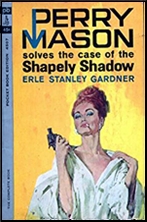
There are a number of intriguing elements in this Perry Mason novel from Gardner’s final period, but like so many other late Masons, the finished product is a mess.
\
The story begins when a beautiful secretary who deliberately makes her-self look unattractive dumps a suitcase full of twenty do1lar bills and an ethical problem in the lawyer’s lap, thereby entangling him in the murder of her boss and the machinations of the three women in the corpse’s life.
The background material on railroad-station lockers and Mason’s savage courtroom deflation of a hostile medical witness are beautifully handled, but there are countless logical holes left unplugged, the motivation becomes ludicrous at crucial points, the plot depends on a chain of multiple coincidences,and the Least Likely Suspect is about as obvious as a leper in a nudist camp.
– This review first appeared in The MYSTERY FANcier, January 1977 (Vol. 1, No. 1)
Wed 19 Oct 2022
Posted by Steve under
Reviews[2] Comments
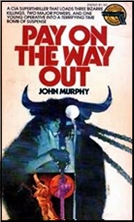
JOHN MURPHY – Pay on the Way Out. Scribner, hardcover, 1975. Ballantine, paperback, 1976.
As if the CIA didn’t have enough trouble after Watergate. Young trainee James Hagen is assigned to investigate the strange assassination of a bullfighter in Spain, and all his clues lead straight to a plot inside the Agency, and worse, by his immediate superiors.
Good detective work early on, but both it and Hagen are caught up in the wheels of intrigue as they grind slowly but surely down. His choice is to run for cover until he can make a stand. A tale put nicely together, but the twists take it away subtly from the reader, who feels nearly as helpless as Hagen does, before the dawn.
Rating: B
– Slightly revised from The MYSTERY FANcier, January 1977 (Vol. 1, No. 1)
UPDATE. John Murphy was the pen name of R. C. Grady, Jr. As Murphy he was the author of three other titles in Hubin, all of which also appear to be thrillers of one form or another.
Next Page »



















